OLD old pole
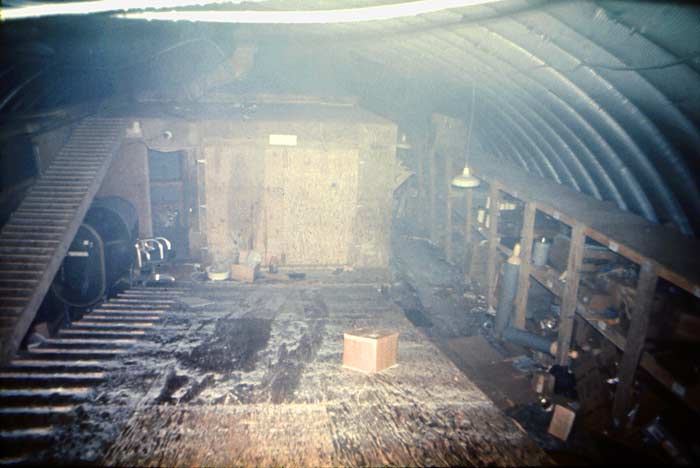 A view down the supply tunnel from the main tunnel. During the summer the far end (behind the structures) would have been dug out to bring in the cargo... 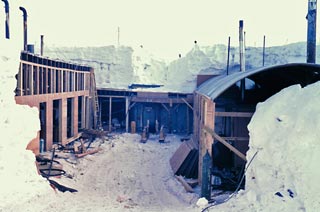
These next two pictures do not come from our 1976-77 era, but I stumbled upon them in the Antarctic section of the NOAA web site photo archive which I highly recommend. These pictures are credited to the National Oceanic and Atmospheric Administration/ Department of Commerce. The photos were undated, so I originally thought they were recent stuff documenting the demolition and retrograde of old pole. In 1999 I contacted the photographer Fred Walton (who was still with NOAA at the time but has since retired). He replied as follows... "For the context ... I wintered over during 1968 ... from early December 1967 until late December 1968... "The two pictures in question show the main generator building. Number 1466 [below right] is the main generator building and number 1467 [above left] is looking down the "builder's tunnel" from outside, with the main generator building on the [left] and the head on the right. The generator building was seriously collapsing during w/o 1967 and a construction crew came in during December 1967, January 1968 to rebuild and shore up the building prior to w/o 1968. A large area of tunnels/buildings is uncovered for the construction. An unfortunate coincidence is that shortly after the construction, in early February 1968, one of the generators lost it's governor, and went into instant self destruct mode. I have a chunk of piston from that episode sitting on a bookcase at home. That piece of piston wedged itself into one of the new overhead timbers and forced some hasty re-construction. Other pieces of shrapnel, ex pistons, rods, bearings, etc, were found in other unlikely locations." On this web site I've tried to adjust the colors and improve the focus a bit while shrinking the file size. Here is a direct link to the original of the photo at left above view from the NOAA site, which also links to the full sized photo. Where's the builder's tunnel? Here's another link to my map. Note that unlike the supply tunnel (at the top of this page), the builder's tunnel was not in an arch; rather it was supported between the buildings by timber framing which was dug out and removed when the 1967-68 work was taking place. By the way, since 1968 the main power plant was moved at least one more time, to the location shown on my map. In 1977 that structure was drifted/iced in and inaccessible. We were able to get to the backup generator which was in a different tunnel. In the 90's Kim Stanley Robinson wrote about it in his book Antarctica, so he found it too... The above view of the builder's tunnel is looking north; in the center background is the older portion of the station. The building visible there is the builders/UT shop which housed the water tanks and steam bath (that building was the original 1957 garage). 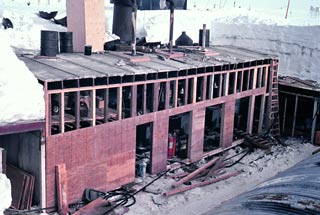
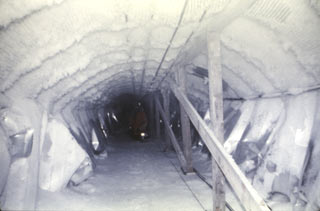 At left is the station (east) end of the seismo tunnel in 1977. I've seen pictures of this from 1973 and from the late 1990's and the view didn't seem to have changed much. We did have to do some serious crawling to get to the seismo vaults and nonmagnetic huts at the far end, where we recovered some nonferrous heating fixtures for Alex's geomagnetic hut. The main danger to human life in these tunnels (other than the cold) is NOT the risk of sudden collapse of the snow and ice above your head. Rather it is the fact that the uneven loads from this overburden has been slowly overstressing the construction materials (wood and steel) over the years, so that a brush with your mitten might be the final few ounces needed for a structural member to yield, or for an arch rivet to break loose like a bullet (some arch rivets were missing, and pieces of them could be found on the arch floors). From my observations and readings in the 1980's and 90's, the snow cover over this station was not increasing. It may have been decreasing due to wind action, since there was little surface disturbance, and some of the surface structures (aurora tower (skylab), RAWIN tower, BIT etc.) have been removed. 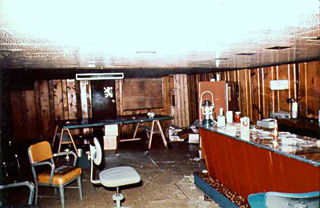
At right, Club 90 South as it looked in 1976...for some unknown reason, there are boxes under the table which are full of eggs (!) This structure was rebuilt from the original berthing building that Paul Siple's group assembled during the first year; often later on it was used for overflow berthing during the summer. One thing we learned was that one of the doors had the knob on the wrong side. 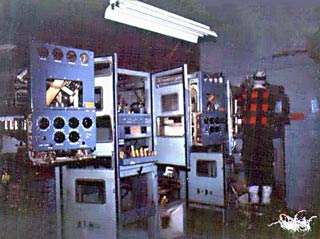
Here's the comm center--when this picture was taken there were still a lot of interesting equipment and spare parts in here. Dave is salvaging some of the meters from the front panels.  The library. All of the shelves were empty except for the religious books and some Navy training manuals... 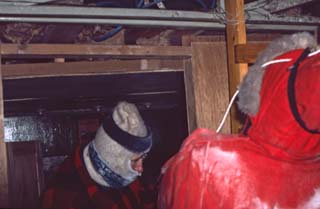 Time to leave...I'm not sure where we are, but it is at the bottom of one of several wood escape ladders that went to the surface. They were sticking up above the snow level and had a square plywood cover. |